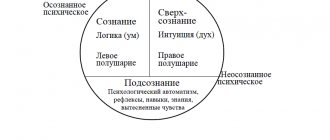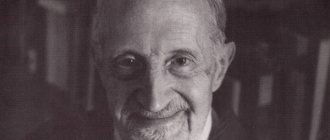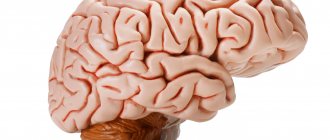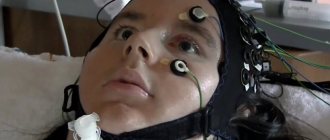The term “subconscious” was introduced into science in 1889 by the French psychologist and neuropathologist Pierre Janet in one of his philosophical dissertations. Modern debates about the subconscious arise in 1869, while the German philosopher and psychologist E. Hartmann publishes his work “Philosophy of the Subconscious.” And it’s not for nothing that the concept of the subconscious is associated with the name of Sigmund Freud, an Austrian psychiatrist, psychoanalyst and neurologist. Freud did use the term “subconscious” in his works, but later replaced it with the concept “unconscious”.
Cognitive psychology also mentions the human subconscious. This term has been used to refer to the area of rapid memory . In this area, the brain records thoughts to which a person attaches special importance, since they are often repeated.
What is the subconscious?
This is the area of the human psyche responsible for storing incoming information and its analysis, unconditioned reflexes; these are not mental processes controlled by the brain. It is often associated with fears and doubts that have no particular reason, intuition, and uncertainty about one’s actions and oneself.
The subconscious mind tries to protect a person, protect him from various dangers and help him cope with life’s problems. All people's actions have meaning, even those they cannot explain. Often they try to explain our habits, actions, preferences with the subconscious, because it gradually accumulates information about human life, displays a person’s experiences and emotions. In a person’s subconscious, even information that he does not remember can be stored and manifested in the most unexpected moments of life.
The power of the subconscious
“The subconscious is wise,” many people say, surrendering themselves to the will of their subconscious. It does everything only with good intentions. But why then are so many people unhappy? Is this subconscious unwise? Or does the person himself simply not understand what the subconscious is and what function it performs?
The subconscious is a set of programs, template phrases, beliefs, points of view, experience, actual conclusions drawn, etc. That is, it is the repository of all the knowledge and beliefs that have been implanted in you since your birth. And therefore, if in your subconscious there is a program “If there is danger, run away,” then you will run away from all problems, difficulties, threats, without even paying attention to the fact that, having overcome all these obstacles, you can achieve something better.
The subconscious is wise. But it is necessary to understand that the function of the subconscious is aimed at preserving the familiar that a person already has. Between the choice of “change your life” or “live as you lived,” the subconscious will choose the second option. The subconscious will strive to force a person not to change anything in his life. This is better than a person starting to change something in himself and putting his life in danger. The subconscious mind takes care of saving a person’s life. It is already sure that a person will live if he doesn’t change anything in his life.
The subconscious’s ideas about what is good can differ significantly from the person’s own ideas about what is good. The subconscious is wise, but this does not mean that it will move a person towards wealth, fame, love, health, etc. Let us once again recall that the subconscious is a set of those beliefs, stereotypes, patterns, rules and other mental installations that have been embedded in it since your birth. And if in your subconscious, for example, there is an attitude from your parents that “money is evil,” then no matter how much you want it, your subconscious will only hinder you from becoming a rich person.
The subconscious mind will maintain your usual lifestyle. It will strive to preserve your life, which is only possible when you live in your usual way. But a person is often dissatisfied with what he has, living his usual life. And in this case, relying on your subconscious is the wrong way. The subconscious mind is wise, but it will always act within the framework of those beliefs and rules in which you sincerely believe. And if this does not suit you, then you will have to change your own beliefs and force your subconscious to change, restructure, so that now it begins to believe in something else and push you to do the actions that you would like to do.
- Why does a person want to do something, but in a stressful situation he does his usual actions?
- Why is it difficult for a person to change his habits?
- Why does a person want to live happily, but end up living in the way he or she is accustomed to?
- Why is it difficult to change anything in your life?
Psychologists find one answer to all these questions and similar ones: this is how the power of the subconscious operates. Everything that is put into it will affect the person and his life. Since a person does not always understand what is happening to him, it is difficult for him to change anything about himself.
Thanks to brain activity, man stood out from the animal world. He does not have the same physical strength, speed and ability to fly as animals. The only distinguishing advantage of a person is his multi-layered and complex brain.
Scientists studying this organ have identified the following main features:
- The brain reinforces repeated actions, creating habits from them.
- The behavior that dominates becomes a habit.
- All a person’s habits are stored in his subconscious.
A habit, or a dynamic stereotype, is a behavior that a person does not think about. They are not congenital, but acquired over the years. If in animals habits are acquired through training, then in humans they are acquired through education.
To form habits you need emotional coloring. It doesn't matter whether it's positive or negative, it gets ingrained in the human brain. Moreover, people use the “carrot” to make a person develop exclusively positive habits, and the “stick” to eliminate negative habits. However, the subconscious does not understand what is good and bad. If a person is accustomed to doing something, then he will resort to this behavior.
It is very difficult for the human brain to break any habits. Why? Because it is first programmed for a certain behavior, which gives a feeling of security and safety, and then they want to change it. If the brain perceives a certain habit as safe for life, peace of mind or satisfaction, then it will not allow it to be changed.
It doesn't matter how bad the habit is according to social opinion. If this habit provides some benefit to the human brain, then it will retain it and return the person to it.
Like habits, dominants matter to the brain - these are the so-called significant reactions compared to others. For example, if a person experiences hunger, then no matter where he is, no matter what he does, no matter what he is passionate about, he will begin to think about eating. Bad dominants are those who do not find their satisfaction. For example, preoccupation with wealth without achieving what you want leads to a depressed mood.
It is necessary to distinguish the subconscious from the conscious. The subconscious is aimed at preserving human life, and consciousness is aimed at preserving a person in society. Thus, the conscious mind often contradicts the subconscious with its desires and aspirations. If, for example, in order to achieve wealth a person sacrifices his health, then often wealth consciously becomes the main priority, while the subconscious mind will slow the person down on the path to his goal, since this is harmful to his health.
Thoughts are material
Many scientists say that thoughts are material. What does this depend on? Everything a person thinks about (everything that he is conscious of) is put aside at the subconscious level. Thus, a person seems to give himself instructions on how to proceed . For example, a person says: “I’m such a loser, I got a few loans again. How to give them away now? And utility bills have increased, and I’m stuck in traffic again! And tomorrow everything will probably only get worse.” In this case, this person’s subconscious will do everything to make the spoken words (or just thoughts in the head) become a reality.
It turns out that consciousness can control the subconscious, which can send signals to a person’s brain and encourage certain actions. Thus, thoughts actually become material.
The subconscious is such a large database that stores information about all the events that have happened in a person’s life. Every minute, every second of a person’s past (not to mention days, months, years!) is imprinted in the subconscious and supported by sensations, emotions, thoughts associated with this moment.
Another feature of the subconscious is its continuous, round-the-clock work . This means that information is recorded regardless of whether the person is awake or asleep.
One of the main roles of the subconscious is maintaining a person’s mental balance . When he leaves his comfort zone, unpleasant sensations take possession of him, and the person is protected by the subconscious.
The subconscious is an amazing, unique and still unknown side of the human psyche, which contains enormous potential for self-healing (mostly internal), changing reality, and self-development.
Often they do not know how to control the subconscious. Such treatment directs a person’s potential into a destructive channel, which can lead to an endlessly long series of problems. Every action performed, idea that appears, and every emotion experienced comes from the subconscious.
How to look into the subconscious
It is impossible to directly establish contact with the subconscious, as well as to control it. At least, this is from the area of esotericism and mysticism, and not psychology. But you can still look into the kitchen of this mysterious area of our psyche. A kind of door there is sleep.
Dreams are games of the subconscious
Sleep is not just the rest we need; its functions are much broader. And when consciousness falls asleep, many processes in our body are activated, including the subconscious. The sleep of the mind opens a passage into this sphere of the psyche, and we can see a kaleidoscope of images, strange, surprising, and sometimes scary or delusional.
Dreams carry information about what is happening in the subconscious, and it, in turn, sends us signals, hints at some important processes or possible events in the future. Deciphering these signals is not at all easy, since the subconscious uses completely different coding methods that are incomprehensible to our minds. Many psychologists have tried to unravel these codes, and the most famous works in this area belong to S. Freud and C. Jung.
People often look for clues to chaotic, fantastic dream images in various dream books. But this is a useless exercise. Are our dreams connected to reality? Without a doubt. After all, it is from the real world that the subconscious receives information and in a dream shares with us the results of its processing and analysis. But the visions sent by our subconscious have nothing to do with the dream books compiled by someone.
Still, you can learn something from dreams, guess about hidden processes or foresee some future changes in the body that the subconscious already knows about, but we don’t yet. But for this, a simple desire is not enough; you need to be especially careful and use specially developed techniques.
How to explain a person's behavioral pattern?
Quite often, a person himself lays down attitudes programmed in the subconscious, suppresses the strongest emotions and feelings, and thinks destructively. We should not forget about the influence of the upbringing of parents, as well as other distant relatives, who instill in the child behavioral norms, principles of morality and ethics from an early age. They also unconsciously impose their vision of the world on the child.
It is worth noting the influence of the media, advertising, society, which constantly lays down all kinds of programs that destroy the subconscious. Typically, the media use special techniques that are based on neurolinguistic programming . Such techniques allow you to quietly introduce the necessary information, bypassing the sphere of logical assessment directly to the subconscious level.
Managing what is hidden in the mind is the key to prosperity, already 90% of success. To achieve what you want, it is necessary to reorient all the resources of the subconscious in the right direction: to invest in such addictive settings and programs that lead to solving problems. You need to constantly give yourself positive commands and calls to action.
The first step on the road to understanding the subconscious is a painstaking analysis of your psychological state, as well as turning off the unconscious “autopilot”, which cannot be controlled. Mental health professionals can help you understand the order of your own thoughts and subconscious feelings, but you can learn to monitor your subconscious on your own.
Consciousness and subconsciousness - the difference between concepts
Figuratively speaking, consciousness and subconsciousness are equal parts of the human mind, which are regularly used by a person to solve everyday or industrial problems. Sometimes they can conflict. Like the hemispheres of the brain, there is a distribution of functions between them for which they are responsible. But it is still a rather little-understood part of human personality.
Articles on the topic
- Stages of alcoholism in women: main signs 06/24/2021
- Split personality: symptoms and signs of the disease in women 06.24.2021
- The main symptoms of nervous exhaustion in women and treatment rules 06/09/2021
- What does transference and countertransference mean in psychology 04/22/2021
The subconscious mind is responsible for:
- intuition;
- instincts;
- inner self;
- sensations, feelings.
According to research, the subconscious is used 95%, while the conscious mind is used only 10%. All this is practically not controlled by the human mind. However, they take a direct part in shaping his worldview, control behavior, influencing life in every possible way. However, people usually don’t even notice it.
It is very easy to understand the difference between them. The conscious mind is also called the objective mind. Simply put, this is that part of a person’s personality that decided to pick up and read some text. But the subconscious mind is responsible for deciphering symbols on the mental screen, converting letters into words, taking out well-imprinted images from memory and combining them into a single whole. In addition, it is also responsible for the functioning of the person himself. For example, the frequency of the heartbeat, and some other processes that consciousness does not even remember.
What is needed to work with the subconscious?
So, you will need the following:
- discover what fears consciousness cannot release from the subconscious;
- find and think about those thoughts that are repeated many times every day and do not allow you to relax;
- understand what exactly consciousness wants;
- explore and study in detail the reaction of consciousness to everything new, contrary to the subconscious program that existed before.
Controlling a person’s subconscious is found in many areas of his life. For example, network marketing, advertising, news. The list can be continued further, but let’s dwell at least on these points. In advertising, the method most often used to influence consciousness is repeated repetition . After numerous viewings of an advertising video with a certain product in a store, a person believes that he is making a conscious choice, but this is not so - he was influenced.
The way to influence consciousness in network marketing is to make a strong impression. If a person dreams of traveling, they tell him about this opportunity.
With the help of frame 25, information can also be imposed on viewers of television channels. You can learn to communicate with your subconscious. To do this, a person must learn to see his desires in clear outlines and imagine them using visual, sensory and auditory methods.
Thoughts that are in a state of gratitude help change human existence in the necessary direction and live harmoniously. to feel gratitude more often for everything that happens around you, regardless of whether it is pleasant or, conversely, annoying.
It does not matter at all how the response from the person’s subconscious was achieved. The most important thing is the desire to change your existence for the better.
From a person’s subconscious, you can also learn to reduce the amount of negativity in the body that has accumulated during the day. To do this, in a cozy environment (for example, at home), you need to sit in a comfortable position, be sure to relax and imagine how all the negativity accumulated over the day disappears, evaporates, evaporates into the air. The main thing is faith in the pictures and images that flicker in the subconscious.
It must be remembered that words are a very powerful weapon, which can sometimes harm both the listener and the speaker. Because of misunderstandings, people often use words against themselves rather than for good. In order for the human word to transform from an impressive weapon into an assistant that can be controlled, you need to try to monitor your speech for at least seven to eight days. During this period, it is strictly forbidden to speak badly about other people and yourself and emit negative energy.
How to influence the subconscious
Sooner or later, we all want to change some of our typical reactions. This is where we come across our subconscious. And visualizations, affirmations, persuasion and threats to oneself begin. Yes, a lot of things begin, especially if we are very persistent. How to influence the subconscious?
Creative thinking
- First rule: the subconscious does not understand words
The subconscious operates exclusively with images. And you need to influence the subconscious using images. It will perfectly understand what a pink elephant with blue polka dots is, even though such a thing does not exist in nature. But if you try to get from the unconscious success or triumph that fully exists in this life, then you will never get it. Until you visualize success in images, there will be no result.
- Second rule: concerns the particle not and the negation of something
In many books on psychology they write that the statement should be positive. But they don't explain why this is important. And this brings us back to rule number 1. Remember, the subconscious mind thinks in images. Let's imagine you give your subconscious a command: I want not to get sick. We translate the phrase “not to get sick” into an image, and we get the image of ourselves being sick, but crossed out. This is the command our subconscious receives: the image of a sick self with denial. He simply does not have the image of being healthy, hence the result. It’s the same as coming to the station and asking for a “ticket from here,” I think it will take you a long time to buy it.
- Third rule: Your new image, your desired future (health, confidence, home, etc.) must be filled with the energy of emotions
You should imagine your desire and feel how excited you are that it will be so. And see how it will change your future for the better, what you will gain if you have a new reaction to the situation.
- Fourth: Remember that the subconscious is stupid :)))
He needs to chew everything like a small child. Remember the old joke about the black man who wanted to be white, where there was a lot of water and women. The subconscious also cannot be left with the possibility of different interpretations of your image and its conditions, otherwise you will get an unexpected result.
For example, one girl wanted to lose weight. Her image of a positive future included the following phrase: when I lose weight, love will appear in my life. After a few months, she stopped losing weight, despite following the diet. After much digging, it turned out that her neighbor Lyuba was placed in her dorm room. What does it look like to the subconscious: Love has come into her life, which means she no longer needs to lose weight.
The role of consciousness and subconscious in psychology
Modern science believes that the psyche is located in the brain. Therefore, there is a conditional place for the conscious and subconscious.
In general, according to psychologists, a person is structured approximately as follows:
- the brain, which acts as the main processor;
- consciousness is a kind of operative memory;
- soul - operational memory;
- subconscious and unconscious are short-term and long-term memory, respectively.
This analogy with a computer is not in vain. The brain has been studied rather poorly, but scientists sometimes manage to find some parallels in their functioning. For now, only one thing is clear: the secrets of the brain will be revealed gradually.
The human consciousness and subconscious, their innermost meaning and all functions, will become known only when scientists can fully understand the entire structure of the brain.
All people can be divided according to their methods of receiving and processing information. Scientists have identified three types:
- Visuals - extract more information from visual images.
- Auditory learners - prefer sounds.
- Kinesthetics - perceive touch and bodily contact better.
This directly affects the subconscious and what information is deposited in it. Initially, it has a certain amount of knowledge, which is gradually replenished over the course of life. For example, moving your hand along a certain trajectory or the same reading. A person fills his “luggage” himself, from where he then takes out new “things”. Whether this has a limit remains to be determined by specialists.
And although the work of the conscious and subconscious has a great influence on a person, they can sometimes come into conflict.
This is especially true for information that does not correspond to any internal attitudes. The subconscious may begin to resist, and then mental problems will certainly arise.
To learn to fully manage yourself and control all aspects of your personality, you need a lot of practice.










